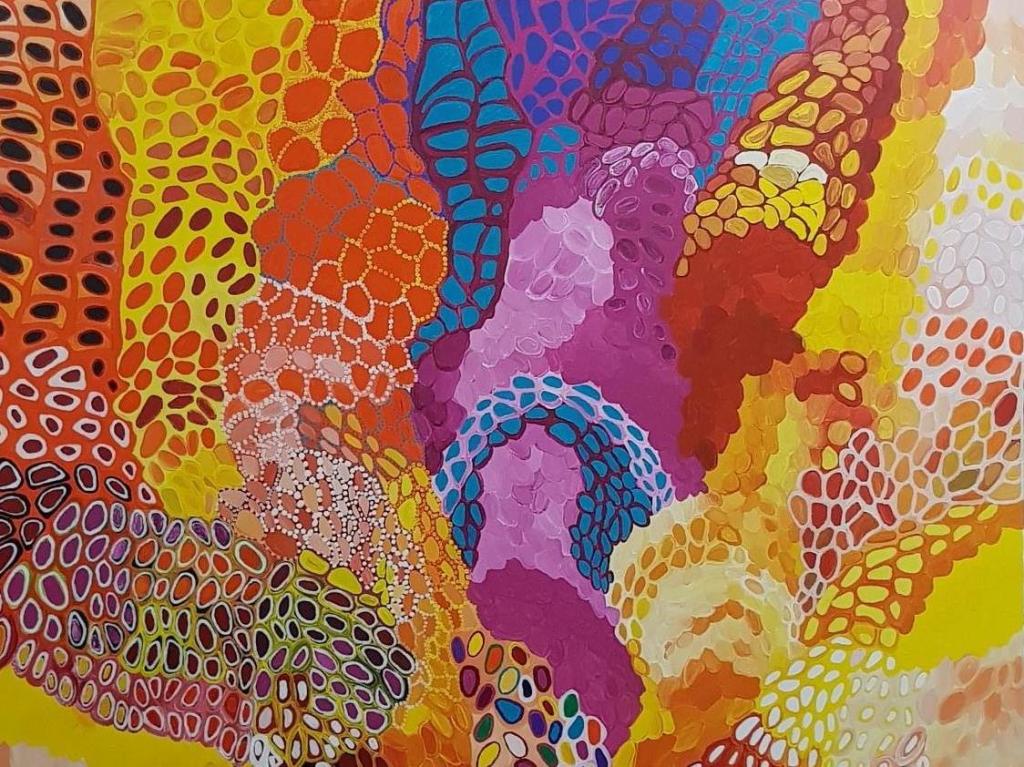Amanda Jane Gabori, My Country 2018 (detail), 197 x 196 cms. Acrylic on canvas.
Mornington Island Art is one of the longest established Indigenous art and cultural organisations in Australia. Mornington Island is a small island of rich cultural traditions, located in the south-east corner of the Gulf of Carpentaria in Queensland. Fully owned and controlled by The Mirndiyan Gununa Aboriginal Corporation, Mornington Island Art delivers locally relevant programs that produce internationally significant artwork.
Established in 2005, Mornington Island Art is now a thriving centre. It began when a remarkable group of women led by Mirdidingkingathi Jurwarnda Sally Gabori, her two sisters and four nieces, came together to paint and share their experiences. These artists have since earned international acclaim with their uniquely colourful and vibrant works. The energy and activity within the centre, combined with its remote location and isolation from mainland and mainstream influences, results in work that is original and contemporary.
‘Our purpose is to maintain and develop the cultures of the Lardil and Kaiadilt people, strengthen our Community and promote our Culture to the rest of the world,’ said MIART’s manager John Armstrong.
Characterised by a vivid and colourful palette and semi-abstract and abstract lines, shapes and forms, the Mornington Island artists are making strong contemporary artworks, not just strong Aboriginal artworks. Although the boundaries between Indigenous and non-Indigenous artwork are increasingly blurred, the work produced at MIART is a fusion of the traditional and the modern.
The Mornington Island artists are still heavily influenced by, and connected to, the land and culture in their artistic interpretations. Their physical and geographical remoteness means the artists do draw significantly on their cultural traditions and spiritual beliefs for inspiration. These are all centred on their strong connection to Country.
The MIART artists work in many different mediums including painting, fabrics and fashion, music and dance, and story-telling to express their art and ideas. The MIART studio is a place of shared culture and creativity, where stories are told and shared memories are kept alive. Language is integral to all the creative activities at the Art Centre whose primary purpose is to maintain and develop the cultures of the Lardil and Kaiadilt people by strengthening the community and promoting its unique stories, nationally and internationally.
The Mornington Island artists include Amanda Jane Gabori, Kaye Bush, Johnny Williams, Amy Loogatha, and Dorothy Gabori. The forerunner of this movement was the late Sally Gabori and many members of the Gabori family are still involved in the centre.
‘I paint because I love it and I love My Country. It’s a very special place with lots of good and not so good memories. The rocks of My Country are in my paintings and the colours of My Country are there too,’ said Amanda Jane Gabori Dibirdibi who has lived on Mornington Island for most of her life. She recently held a successful exhibition at the Woolloongabba Art Gallery in Queensland and was also the Mirndiyan Gununa feature artist at the 2018 Darwin Aboriginal Art Fair.
Amanda Jane is the youngest daughter of the great Mirdidingkingathi Juwarnda Sally Gabori. She works in a vibrant, colourful style which is radically different from much of the traditional Indigenous art practice. ‘Her work uses simple motifs to create complex and evocative works attuned with sadness,’ said Armstrong.
Many of the MIART artists create works that are spiritually charged, immediately joyful, rich and exuberant, yet also reflective of a deep sadness that permeates their history.
The gestural paintings for which Sally Gabori made her name speak directly to her connection to Bentinck Island and the longing Armstrong identifies in Amanda’s work may be attributed to the intergenerational trauma of removal from Country. In 1914 Presbyterian missionaries settled on the island and gathered together the language groups of the Lardil, Kaiadilt and Yangkaal people.
‘I found the phases Amanda is going through fascinating; she is pushing herself with different styles. Amongst the group of current Kaiadilt women artists, Amanda stood out for us. She is incorporating what Sally and Netta Loogatha were doing in early years, absorbing it all into her own style and experimenting,’ said Armstrong.
The MIART Studio at Mirndiyan Gununa is a place of stories, a place where artists keep their cultures and stories alive and vital. It is also a special place where the artists share their memories and sorrows while they create works of compelling vibrancy that reflect the real or imagined landscapes of Country.
Visit www.morningtonisland.com.au (currently under reconstruction) and www.facebook.com/morningtonisland for more details about Mornington Island Art.





